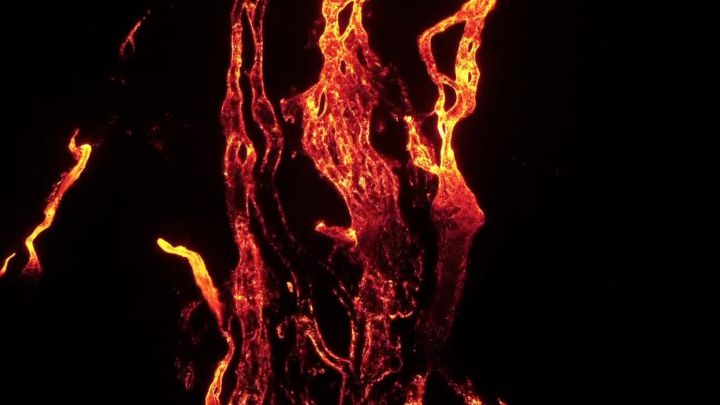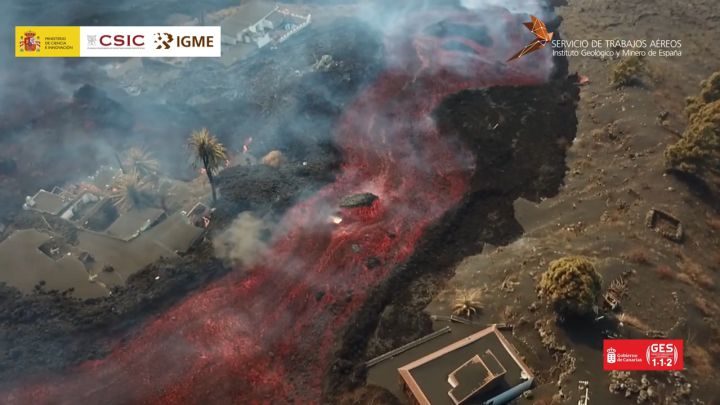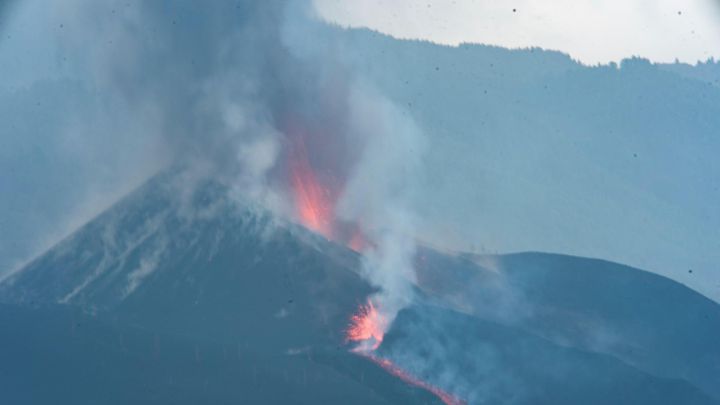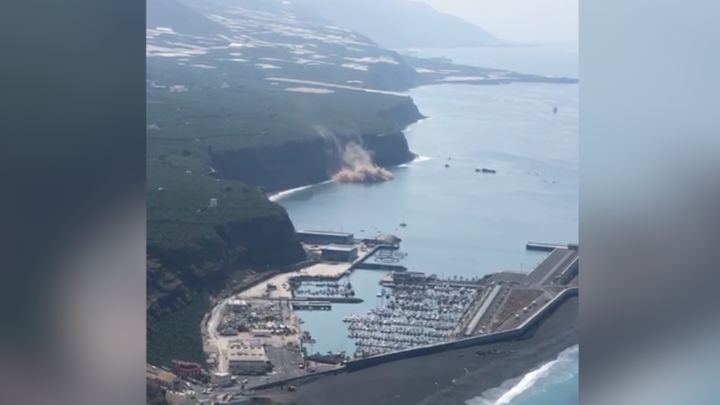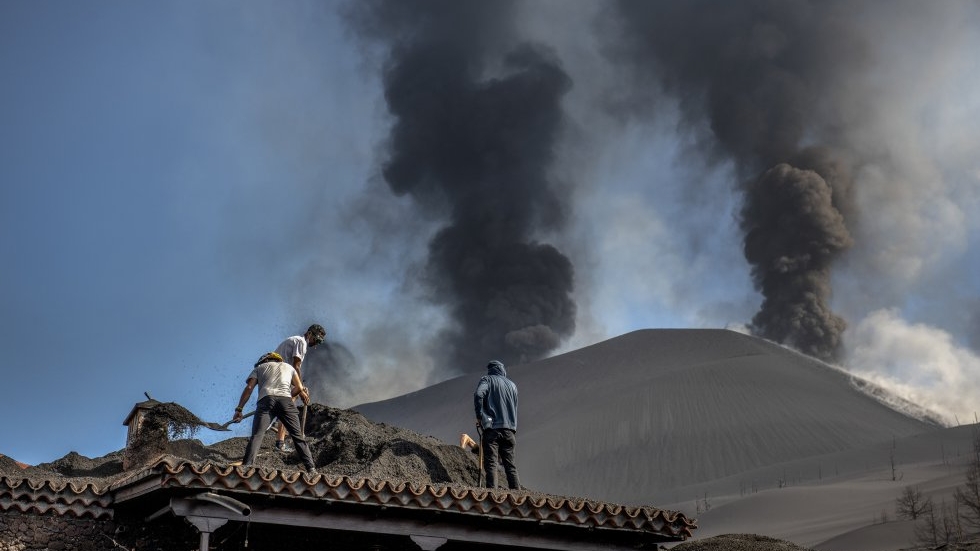La Palma volcano, 19 october: eruption, tsunami warning and latest news | Canary Islands
Latest news, information and updates on the eruption of Cumbre Vieja volcano on La Palma, where the lava flow has reached the sea and formed a large delta.
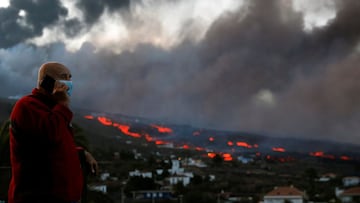
Show key events only
La Palma volcano eruption: live updates
Headlines
- Volcanic activity enters 30th day on Tuesday, having begun on 19 September
- More than 100 tremors were registered in La Palma in the last 24 hours, according to Spain's Instituto Geográfico Nacional
- Lava flow now covers surface area of 811.8hectares according to Copernicus radar imaging, with 22.2 hectares added in just seven hours
- 35,000 earthquakes and tremors recorded in La Palma during the past month
- Nearly 2,000 buildings destroyed by lava flow
- Cumbre Vieja eruption the "most important since 1585", according to Copernicus
- No short or medium term end to eruption claim experts, as more La Palma residents forced to evacuate
- Lava forming huge delta on La Palma coast
- Delta has claimed around 40 hectares of new land from the Atlantic
Useful information
- Volcanologist speaks to AS about the effects of lava reaching the sea
- An overview of the active volcanoes on the Canary Islands
- When was the last volcanic eruption on the Canary Islands?
Cloud cover scuppers Copernicus update
Copernicus, the EU's satellite observation programme, was unable to provide its latest update on the extent of the Cumbre Vieja lava flow late on Tuesday, as cloud cover was obscuring the view in the most recent image taken.
4.1 magnitude earthquake recorded
An earthquake measuring 4.1 on the Richter scale was registered on La Palma late on Tuesday, according to data collected by the Canary Islands Seismic Network.
Lava flow advancing slowly towards sea
TVE’s Leire González reports that experts do not expect a lava flow thatis now some 80 metres from the coast to reach the sea tonight. The lava is advancing at around five metres per hour.
"We cannot risk predicting anything"
One month after the Cumbre Vieja volcano erupted on the Spanish island of La Palma spewing red-hot lava and ash, Culberta Cruz, her husband and their dog are living in a tiny caravan on a parking lot and see no end of the ordeal in sight.
"I'm tired, so tired ... but who are we to fight against nature?," the 56-year-old hospital kitchen worker said, sitting on a camping chair.
Her husband, banana grower Tono Gonzalez, was pulling electric cables and water hoses to connect to the vehicle, with their French bulldog looking on. The couple have been living in the small camping car for a month, constantly brushing off volcanic ash from the vehicle.
"One day it's exploding there, the other a vent opens here, it's just anguish and living in fear, waiting and praying for it to stop erupting," Cruz said. "And it's a lot of sadness for those who lost their homes."
Streams of red-hot lava have engulfed almost 800 hectares (2000 acres) of land, destroying about 2,000 buildings and many banana plantations since the eruption started on Sept. 19. More than 6,000 people have had to leave their homes.
Carmen del Fresno, from the National Geographic Institute's volcano monitoring department, told Reuters the eruption was unlikely to stop for at least another week, but there was no way to predict how long it would last.
"Historical records show eruptions lasting 24 to 84 days... It would be logical to assume something within those bounds, but we cannot risk (predicting) anything."
Involcan working to monitor seismic movements
The Canary Islands Volcanology Institute has been working night and day to keep an eye on seismic activity on La Palma, where around 35,000 earthquakes and tremors have been registered since the Cumbre Vieja eruption began on 19 September.
Where are most volcanoes located?
Volcanism is responsible for over 80 percent of Earth’s surface both above and below sea level, but where are the most volcanoes located today?

This handout photograph taken on Tuesday by the Spanish Military Unit (UME) shows the Cumbre Vieja colcano spewing smoke and ashes, pictured from El Paso, on La Palma.
(Photo by Luismi Ortiz / UME / AFP)
No further evacuations on the cards, but stay-at-home order is
The Cabildo de La Palma, the island’s local government, says it is not considering ordering further evacuations, “as long as the current conditions do not change”. However, the residents of Tazacorte are expected to be told to stay at home when a second lava flow, which is now around 80 metres from the coast, reaches the sea.

La Palma volcano has wiped out 188 hectares of agricultural land
Over 188 hectares of agricultural land on La Palma has been affected by lava flow from the Cumbre Vieja volcano, Alicia Vanoostende, Minister of Agriculture, Livestock and Fisheries announced on Tuesday. Breaking down that figure, the affected areas include 97 hectares dedicated to banana cultivation, 50 hectares of vineyards, 13 hectares used for growing avocado as well as farmland, irrigation systems, fishing boat fleets and other land used for agricultural across the island which has been affected by volcanic ash.

The second trail of lava will hit the sea "within hours"
The second trail of lava which stems from the norther side of Cumbre Vieja is now just 30 metres from the coast and is expected to hit the Atlantic Ocean "within the next few hours". INVOLCAN spokesman David Calvo explained that the volcano was particularly active throughout Monday night and as a result the lava flow has extended substantially, spreading over 100 metres in the space of a few hours.
PEVOLCA grant permission for operation to rescue trapped dogs
Permission has been given to a drone company to go ahead with a rescue plan to save a group of dogs who have spent several days trapped in a water tank in the exclusion zone on La Palma. Technicians from Aerocamaras plan to fly specially-adapted drones into the water tank. They hope to lure the dogs into nets then fly them out to safety.
Jaime Pereira, who is in charge of the operation told Telecinco, "Technically, it is the most complex we have undertaken, by a long way. We are risking a lot but it is an operation which we have to do. The tests we have run worked well, we will need a lot of strength and a lot of luck".
Sulphur dioxide cloud sweeping across Africa and central Europe
The column of sulphur dioxide and other gases emitted by Cumbre Vieja is sweeping across parts of north Africa, central Europe and SO2 from the volcano has been detected as far away as the Caribbean. The extent of the cloud's spread is highlighted in the graphic below, posted on social media by windy.com
Cumbre Vieja has caused unparalleled damage
Of all of the volcanic erruptions that have been recorded on La Palma, none have caused as much damage as the Cumbre Vieja erruption which began on 19 September. Lava from the volcano has so far engulfed 811.8 hectares of the island - almost double the 441 hectares of land which the El Charco erruption of 1712 destroyed in 1712.
Sulfur dioxide emmissions spreading
As seen in the satellite imagery collected by Copernicus, sulfur dioxide (SO2) emissions caused by the Cumbre Vieja volcano is spreading towards Portugal, Spain and Africa's West Coast...
McDonald's raises 35,000 euros for those affected by La Palma
McDonald's announced this Tuesday that it has raised more than 35,000 euros through an initiative launched on 1 October to help all those affected. The global fast food chanin's goal now is to reach 65,000 euros. The president of McDonald's Spain, Luis Quintiliano, has described this gesture as "an example of solidarity of the Spanish people towards La Palma".
Second lava stream 30m from sea
The first stream of lava hit the sea two weeks ago and his since lead to the creation of more than 40 hectares of new land on the coast. Now a second stream of lava is just 30m from the sea.
One month on, La Palma volcano continues to cause destruction
Looking back on 30 days in La Palma
It’s been a month since the new volcano on La Palma began spewing lava, and in all that time the only good news is that there have been no fatalities. El País looks back at the main events of the last 30 days.
More than 100 tremors detected in last 24 hours
More than 100 tremors were registered in La Palma in the last 24 hours, according to Spain's Instituto Geográfico Nacional.
Spanish government sends 10.5m euros for rehousing effort
Spain’s Ministry of the Interior has sent 10.5 million euros to the Canary Islands’ regional government to help pay for the purchase of over 100 homes to rehouse La Palma inhabitants uprooted by the eruption of the Cumbre Vieja volcano.
Interior Minister Fernando Grande-Marlaska signed an order for the transfer of funds on Monday, as part of a La Palma relief package approved by Spain’s Council of Ministers at the end of September.
(Photo: EFE/Chema Moya)
La Palma eruption "the most important since 1585"
According to Copernicus, the EU's satellite observation programme, the ongoing eruption of the Cumbre Vieja volcano has become the most significant volcanic eruption witnessed in just over 500 years, since 1585.

In pictures
In this handout photograph taken and released by the Spanish Military Emergency Unit (UME) on October 18, 2021, a UME member monitors the lava flow of the Cumbre Vieja volcano, near La Laguna, on the Canary Island of La Palma, on October 18, 2021. Beginning on September 19, the latest eruption is the third in a century for La Palma, an island of 85,000 people, after San Juan in 1949 and Teneguia in 1971. So far no-one has been killed by the continuous lava flows, but the molten rock has covered more tjan 800 ectares and destroyed close to 2,00 buildings, including hundreds of homes, according to the European Union's Copernicus disaster monitoring programme. About 7,000 people have been evacuated from their homes on the island, which has a population of around 85,000 people. (Photo: Luismi Ortiz / UME / AFP)
Latest Copernicus update
Copernicus has relased its latest updated based on radar imagery acquired on 17 October at 18:56 UTC:
- Lava flow now covering 811.6 hectates, an increase 22.2 hectares in 7 hours.
- 1,956 buildings destroyed (+121 in7 hours)
La Palma volcano eruption updates: welcome
Hello and welcome to our live blog for Tuesday 20 October 2021, bringing you the latest updates and information on the eruption of the Cumbre Vieja volcano on La Palma.
The lava first began flowing way back on 19 September and many believed it would be short lived. As we now know, this was a long way from what has transpired since.
